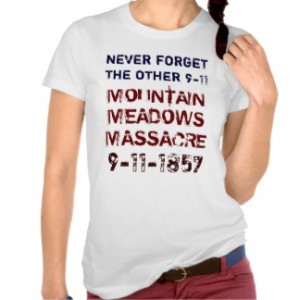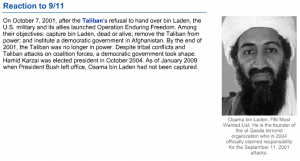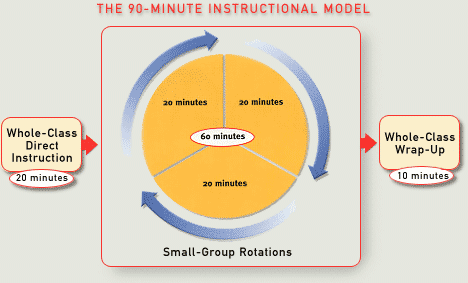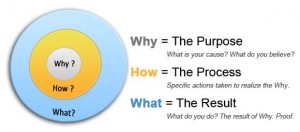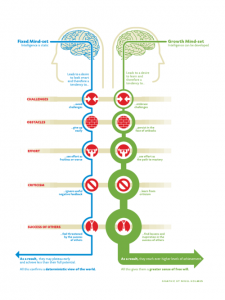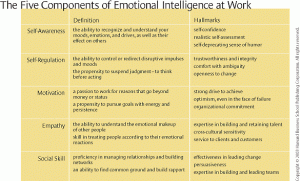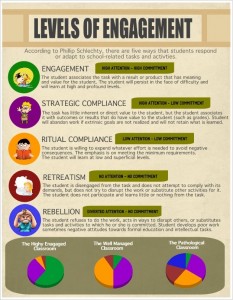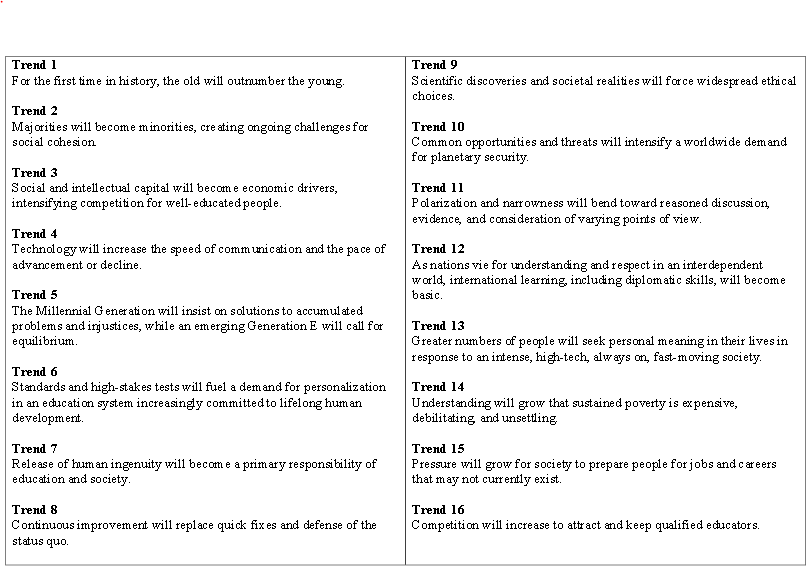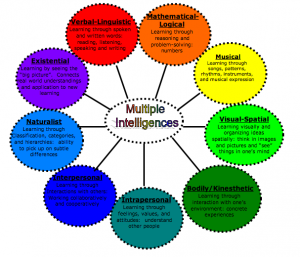The posting of this blog, one may think, is poorly timed. Weeks too late as last month schools marked two global events which use in their moniker “9-11.” Still, both events, assuming classes are taught chronologically, will be relevant later in the school year, and therefore educators can learn from this post. Read on…
In September some students in the USA were taught about the USA’s supported military coup which overthrew Chilean President Salvador Allende on September 11, 1973. “Because of CIA covert intervention in Chile, and the repressive character of General Pinochet’s rule, the coup became the most notorious military takeover in the annals of Latin American history.” The death of Allende yielded to the dictatorship of Augosoto Pinochet until 1990. US foreign policy in Latin America included supporting the policies of anti-democratic regimes. According to the Washington Post, Pinochet’s brutal resume includes the death of “at least 3,197 people and tortured about 29,000.”
Likewise, last month most schools in the US were taught that, twenty-eight years later, two passenger airliners were flown by members of al-Qaeda, mostly from Saudi Arabia, into the iconic World Trade Center “Twin Towers” in New York City and one into the Pentagon near Washington D.C. Nearly 3,000 people perished in the attacks, about 12% of the casualties were from outside of the USA. One outcome of the attacks was a proclaimed “War on Terror” leading the US along a road which is “in theory, an endless war –- a war that approaches something closer to a way of life.” It is important to remember the origin of the attackers. Al Qaeda’s formation is traced back to the late 1980’s, “As Soviet troops withdraw from Afghanistan, Osama Bin Laden and other Arab fighters from the US-backed Mujahideen movement form “al-Qaeda”, which in Arabic means “the base”.”
The number of educational resources that have been created about the 9-11 attacks in 2001 is prolific. My previous blog post here focused on educational resources’ attention to the “why” and “what” of the 9-11 of 2001. This year, I want to examine the narrative that has been created in educational and media sources around the concept of the 9-11 “Mastermind”. I argue that the educational resources are deficient in this area because of the fact that they incorrectly identify Osama Bin Laden as the “Mastermind” of 9-11. The “Mastermind” label, branded on Bin Laden, is presented as a fact, an unchallengeable truth that is replicated and perpetuated in schools vis-a-vis “authoritative” curriculum materials. Strangely enough, this Bin Laden-Mastermind connection exists despite ample evidence from multiple sources (presented below) that the Mastermind of the 9-11 attacks was Khalid Sheik Muhammad (KSM). The absurdity of KSM’s absence in 9-11 educational curriculum materials is magnified by the fact KSM is currently on trial at Guantanamo Bay, Cuba for being the Mastermind of 9-11!
9-11 Resources
So, what is being celebrated by publishers and media as authoritative best practices for and content resources for 9-11? A sample of materials is below. Are they in your department office or library? If so, I hope examine the narrative promoted by them and the evidence they emphasize.
- New York Regent’s Exam Review Guide has no mention of Khalid Sheik Muhammad! Their entry for Osama Bin Laden supports the Bin Laden “Master Mind” claim: “Osama bin Laden: Saudi Arabian multimillionaire and leader of the terrorist organization al-Qaeda. He is responsible for numerous terrorist attacks on the United States including the destruction of the World Trade Center.
- Social Studies Services: Their binder consists of a range of materials, lessons, and sources to be used in class and is “suitable for assemblies.” The resource is an impressive collection and aspires to laudable goals: “Relying on open-ended inquiry, activities also prompt students to interpret photographs, video footage, and oral histories; and to document their findings by means such as Google Earth and a timeline.” Samples can be seen here. The most promising resource is the “Student Handout: Activity2 Timelines pp 28-33. Osama Bin Laden is mentioned over a dozen times and Timothy McVeigh once. But they fall short of mentioning KSM even once.
- Hippocampus: This is an amazing site. “HippoCampus.org is a free, core academic web site that delivers rich multimedia content–videos, animations, and simulations–on general education subjects to middle-school and high-school teachers and college professors, and their students, free of charge.” Their History selections, despite not having a World History offering, boasts regular and AP level content. 9-11 is housed in the “Bush and Obama” unit under two sections:”Reaction to 9/11″ and “Domestic Response to 9/11”. KSM is absent. Bin Laden gets a photo opportunity.
- The History Channel: The have extensive resources – videos, interactives, timelines, photos- on 9-11. The Osama Bin Laden entry identifies him as the mastermind, “On this day in 2011, Osama bin Laden, the mastermind behind the September 11, 2001, terrorist attacks in the United States, is killed by U.S. forces during a raid on his compound hideout in Pakistan. Search History.com’s website for Khalid Sheik Muhammad and you get ZERO results. Search “Ice Road Truckers” or “Swamp People” and you get over 28,000 results…for each of them! Oh History channel, how you are misnamed!
- CNN: Think about it. When did you realize CNN’s reporting moved from news coverage to info-tainment. I think it was the late 90’s, but that is just a guess. Their timeline of 9-11, updated on 9-11-2013, has no reference to KSM! Bin Laden is still identified as the “mastermind”, “This terrorist attack on the United States is orchestrated by al Qaeda leader Osama bin Laden.” However, most ridiculously, CNN still lists the Dec 2001 Bin Laden Confession Tape as a viable part of the narrative “December 13, 2001 – The U.S. government releases a tape in which Osama bin Laden takes responsibility for the attacks.” They fail to mention that this tape came under heavy scrutiny from international media and research organizations.
- Digital History: This online US History survey course has an impressive backing of sponsors. The goal of the project is also This Web site was designed and developed to support the teaching of American History in K-12 schools and colleges and is supported by the College of Education at the University of Houston. Overall this is an impressive project with some expanded features. However, the final unit”The 21st Century” includes a quiz on 9-11. Looking at question 3 below, you should figure out where I am going with this:
3. The mastermind behind the terrorist attack was
a. Timothy McVeigh b. Saddam Hussein c. Osama Bin Laden
I emailed them about this, but never received a response. What a surprise.
KSM, the Mastermind of 9-11, 2001
I lay it out there, Khalid Sheik Muhammad is the master mind of 9-11. Osama Bin Laden is not the mastermind behind 9-11. Therefore, any educational material, standards, test, curriculum, etc, that professes Bin Laden is, needs to explain its stance 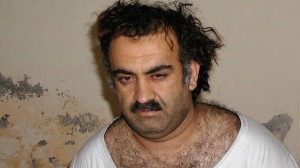 against the sources below. As you review them, please remember, I am arguing that the narrative about the 9-11 Mastermind found in current curriculum resources are faulty, misleading, numbing, and a gross dis-service to the students, teachers, and education profession.
against the sources below. As you review them, please remember, I am arguing that the narrative about the 9-11 Mastermind found in current curriculum resources are faulty, misleading, numbing, and a gross dis-service to the students, teachers, and education profession.
I offer evidence that questions and contradicts those resources. Review them yourself. Come to your own conclusion. Let me know what you think.
- The New Yorker Magazine: In 2010, groups protested the idea of putting KSM on trial in NYC (remember that?). “Greg Manning, whose wife, Laura, was severely burned in the World Trade Center attacks, stood before the crowd and said, “Thousands are already dead because of Khalid Sheikh Mohammed’s choices…There’s a place for the courts, but not for the mastermind of 9/11.”
- The Daily News: Maybe the title says it all “Khalid Sheikh Mohammed, 9/11 mastermind, allowed to build vacuum in CIA prison.” Maybe not. But it is hard to ignore this claim written in July 2013. Too new? Read on…
- 2007 Military Tribunal Transcript: I guess we forget that these documents are, at least theoretically, our possessions. Regardless, this 2007 transcript offers a bit to read about KSM and his role in 9-11. He, and his personal representative, profess “I hereby admit and affirm without duress… I was responsible for the 9/11 operation A to Z”
- Wikilieaks: This memo of “Combatant Status Review” of September 4, 2006 signed by Rear Admiral Harry Harris Jr. is telling. that KSM was the Mastermind of 9-11. Page 5… “Detainee was the mastermind of the 11September 2001 terrorist attacks on the World Trade Center and the Pentagon.” Read for yourself.
- 9-11 Commission Report: I guess this is the smoking gun, if there is to be one. The US committee announced, in 2002, that KSM was the mastermind of 9-11. The group was “an independent, bipartisan commission created by congressional legislation and the signature of President George W. Bush in late 2002, is chartered to prepare a full and complete account of the circumstances surrounding the September 11, 2001 terrorist attacks, including preparedness for and the immediate response to the attacks. The Commission is also mandated to provide recommendations designed to guard against future attacks.” They explicitly state “No one exemplifies the model of the terrorist entrepreneur more clearly than Khalid Sheikh Mohammed, the principal architect of the 9/11 attacks.”
The Atlantic Monthly ran this title in 2012″How the FBI, CIA, and Pakistani intelligence worked together — or didn’t — in the global hunt for the mastermind behind September 11, 2001″… Everything the Americans could rustle up pointed to Karachi. Every source and bit of information said Khalid Sheikh Mohammed was operating out of the capital of Pakistan’s Wild West…
So, where does that leave the us? Survey your colleagues. Ask them who is Khalid Sheikh Mohammad? Ask them who is the “Mastermind of 9-11”? Review the material you use and the narrative about 9-11. Weigh the evidence and ask why is KSM not in the narratives, standards, and curriculum materials for high school students.
I would like to end by noting another type of narrative around 9-11. Both TED videos detail attempts at creating meaningful interpretations of what happened on 9-11. It is important that these messages are in the public sphere, the collective conscious. Take a look and see how they impact your view of 9-11. These voices, emphasizing a social historical approach, remind us that world events and globalization networks are never one-way avenues of “Them” causing harm to “Us.”
Enjoy.

